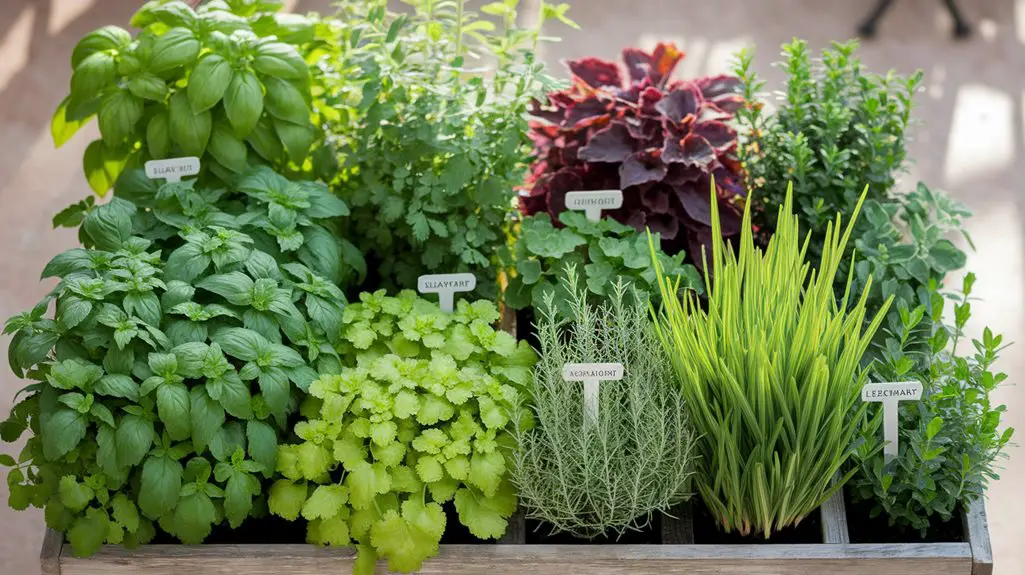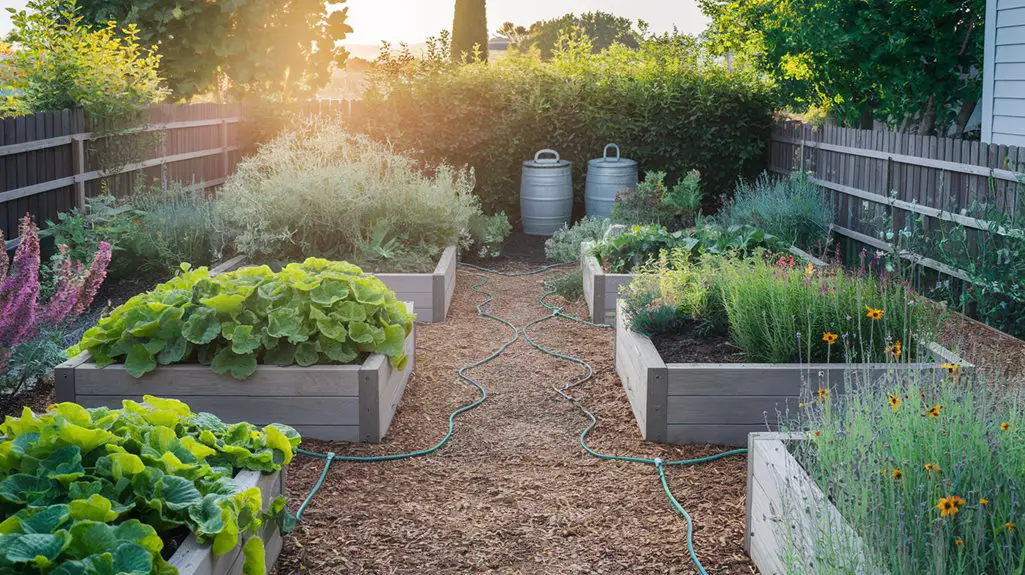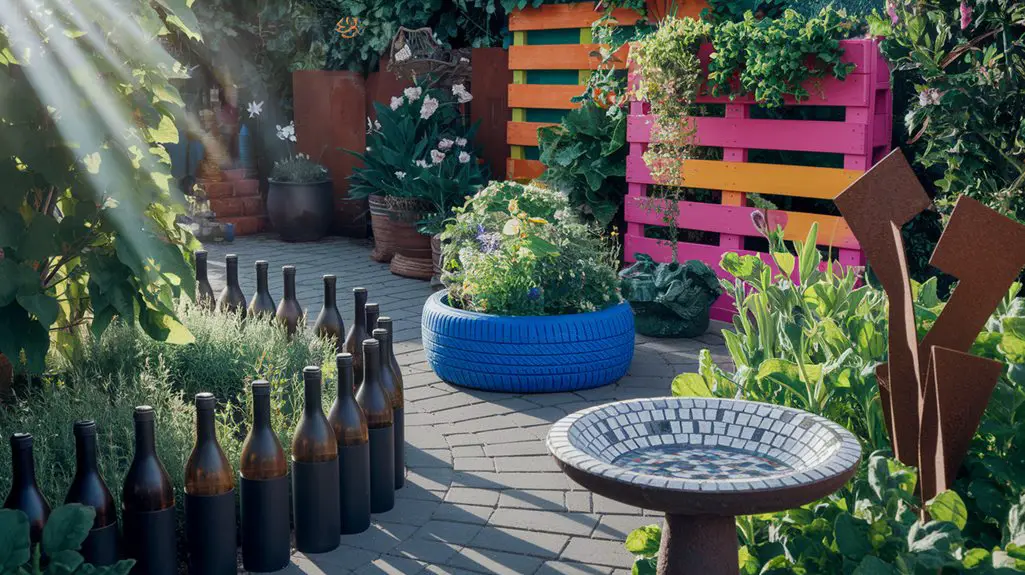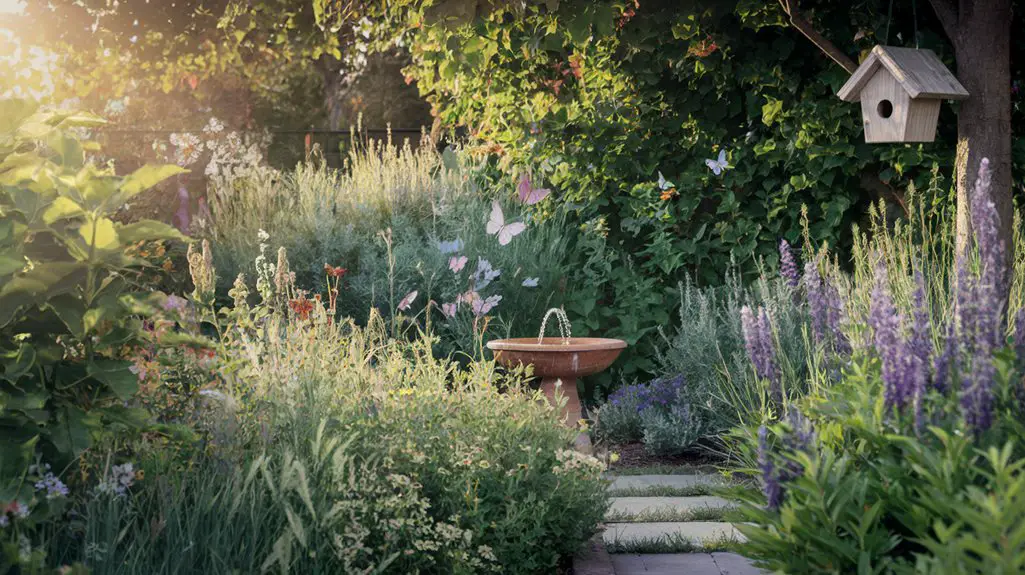Just as a passport opens doors to new cultures, a thoughtfully designed herb garden can transport your cooking across continents without leaving home. You'll discover how fresh herbs transform ordinary meals into authentic culinary experiences, whether you're craving the bright flavors of Mediterranean cuisine or the complex heat of Thai dishes. With just a few square feet of soil or some strategic container placement, your kitchen can become a gateway to worldwide flavor exploration.
Mediterranean Herb Garden: Basil, Oregano, and Thyme
When planning a Mediterranean herb garden, you'll discover a trio of culinary superstars that thrive together beautifully: basil, oregano, and thyme.
These aromatic herbs prefer similar growing conditions—well-draining soil, ample sunshine, and moderate watering.
Plant basil in the center as your garden's showcase, providing it with room to reach its full bushy potential. Position oregano and thyme as ground-covering companions around the perimeter, where they'll spread naturally while deterring weeds.
For peak flavor, harvest basil before it flowers, collect oregano when its oils are most concentrated mid-morning, and snip thyme just before it blooms.
These herbs don't just enhance classic dishes like pasta, pizza, and roasted meats—they also attract beneficial pollinators to your garden while repelling many common pests. Incorporating edible landscaping ideas can further enhance your garden's beauty and productivity.
Asian Fusion Garden: Lemongrass, Thai Basil, and Cilantro
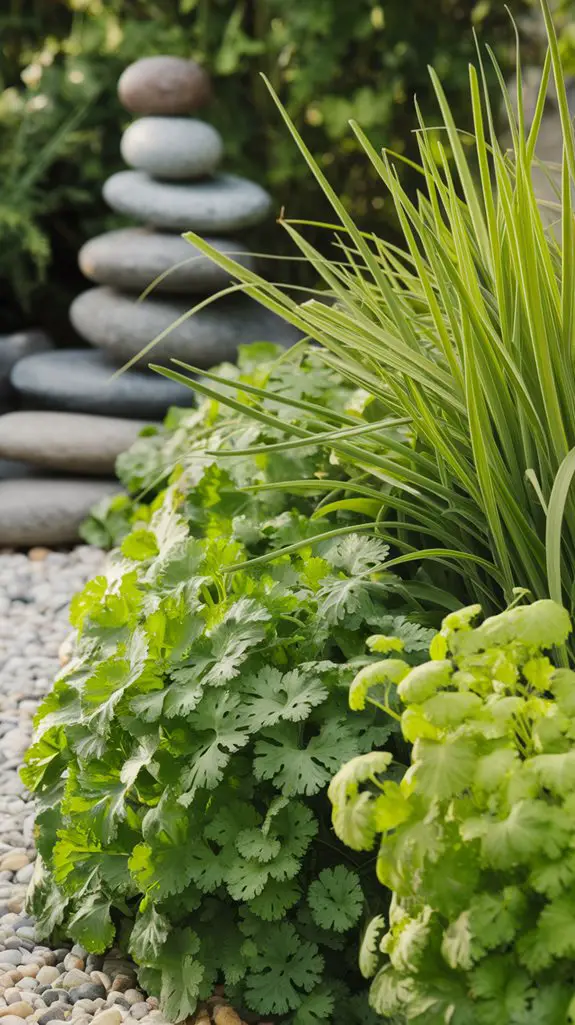
Moving from the Mediterranean to the East, an Asian Fusion herb garden brings exotic flavors and striking visual elements to your outdoor space.
The tall, grass-like stalks of lemongrass create dramatic height while offering citrusy notes perfect for Thai soups and curries.
Thai basil, with its purple stems and distinctive anise flavor, thrives in warm, sunny spots and adds both culinary versatility and visual interest. Unlike its Italian cousin, it retains flavor when cooked at high temperatures.
Cilantro (also called coriander) completes the trio with its bright, divisive flavor that's essential in countless Asian dishes.
Plant it in succession every few weeks for continuous harvest. You'll find these herbs work beautifully together in stir-fries, curries, and fresh spring rolls. Additionally, incorporating organic pest control methods can help maintain the health of your herb garden without harmful chemicals.
Mexican Fiesta Garden: Cilantro, Epazote, and Mexican Oregano
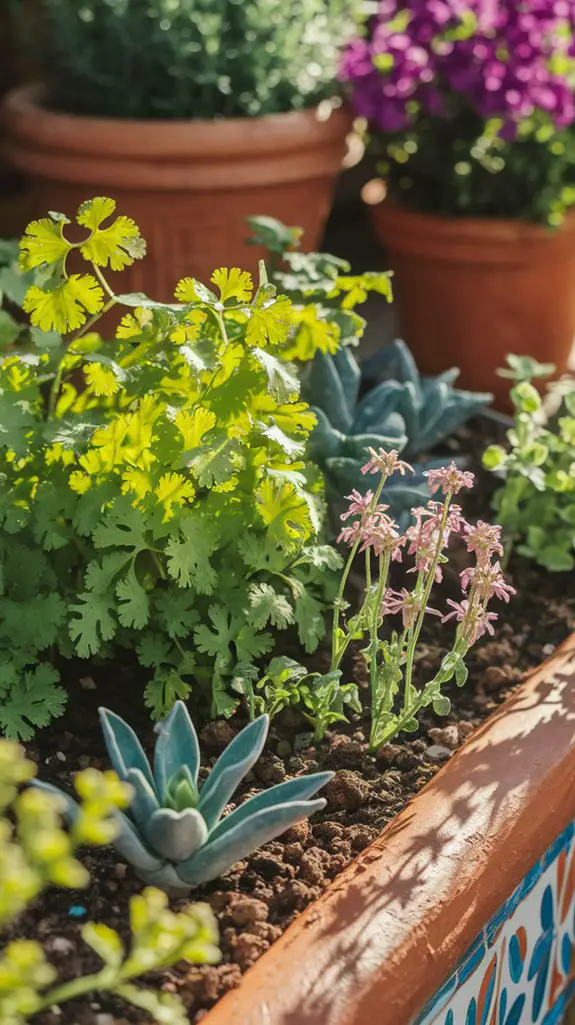
A vibrant Mexican Fiesta herb garden brings three essential flavors to your culinary repertoire while adding distinctive textures to your garden landscape.
Cilantro, with its bright, citrusy profile, thrives in cooler temperatures and provides both leaves and coriander seeds when it bolts. Plant it in succession for continuous harvest.
Epazote, less familiar but indispensable in authentic Mexican cooking, offers a strong, aromatic quality that perfectly complements bean dishes and reduces their gaseous effects. This tall herb needs full sun and well-drained soil.
Mexican oregano, not related to Mediterranean varieties, delivers intense, citrusy notes with hints of licorice. It's drought-tolerant and produces lovely white flowers that attract pollinators. Grow it in containers if you're in cooler regions, as it prefers warmer climates. Additionally, well-drained soil is crucial for the successful growth of these herbs, ensuring they thrive without waterlogging.
Italian Culinary Corner: Rosemary, Basil, and Parsley
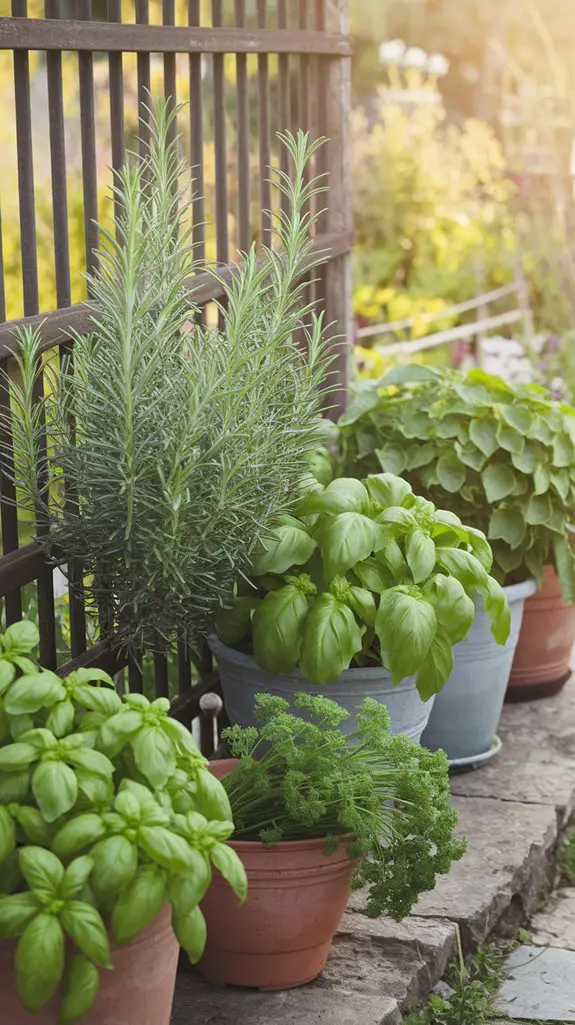
The heart of Italian cuisine grows beautifully in a dedicated herb garden corner featuring three Mediterranean classics.
Plant rosemary as your anchor herb—this woody perennial thrives in sunny, well-drained spots and provides year-round flavor with its aromatic, pine-like needles.
Basil, summer's star herb, demands warm conditions and consistent moisture; 'Genovese' varieties deliver the quintessential sweet, clove-like flavor perfect for pestos and Caprese salads.
Complete your Italian trio with flat-leaf parsley, which offers more robust flavor than its curly cousin and grows easily in partial shade.
For authentic presentation, arrange these herbs in terra cotta pots grouped on a sunny patio, mimicking an Italian countryside aesthetic.
You'll enjoy convenient access to these fundamental flavors that transform ordinary dishes into memorable Italian meals, while also creating a pollinator-friendly environment that supports local ecosystems.
Middle Eastern Herb Collection: Mint, Za'atar, and Sumac
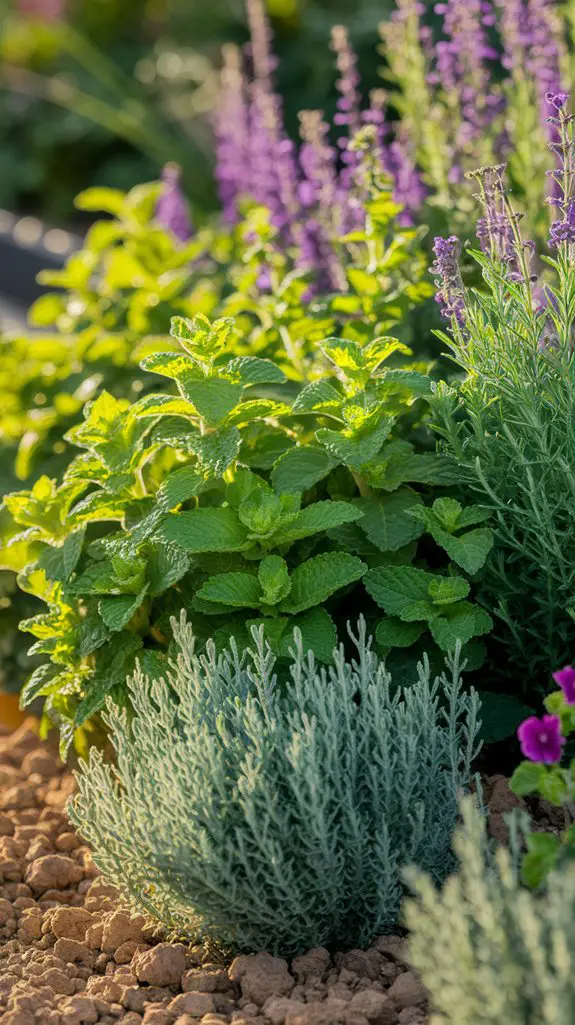
Vibrant flavors of the Middle East transform your garden into an aromatic oasis with the trio of mint, za'atar, and sumac.
Mint thrives in partial shade and moist soil, spreading quickly to provide invigorating leaves for teas and savory dishes like tabbouleh and lamb.
Za'atar, a thyme variety with hints of oregano, prefers well-drained soil and full sun. This versatile herb forms the backbone of the eponymous spice blend that's sprinkled on flatbreads and meats throughout the Levant.
Sumac, with its distinctive deep red berries, grows as a small shrub that adds vertical interest to your garden. The tart, lemony flavor brightens salads, rice dishes, and marinades.
Harvest the berry clusters in late summer for grinding into the signature tangy spice that defines authentic Middle Eastern cuisine.
French Provincial Herbs: Tarragon, Chervil, and Lavender
Transport yourself to Provence with a classic trio of French herbs that embody the region's sophisticated culinary tradition.
French tarragon's distinct anise flavor elevates chicken, fish, and vinaigrettes, while its slender leaves add elegant texture to your garden. Plant it in well-drained soil with partial shade for best results.
Delicate chervil, with its lacy foliage and subtle licorice notes, thrives in cool, damp spots. It's perfect for classic béarnaise sauce and brings a fresh brightness to spring vegetables and omelets.
Lavender serves double duty—its fragrant purple blooms attract pollinators while providing aromatic additions to desserts and Herbes de Provence blends. These herbs thrive in raised bed herb gardens, which help improve drainage and soil quality.
Position lavender in full sun with excellent drainage. Together, these herbs create an authentic French garden experience that's as beautiful as it's useful.
Indian Spice Garden: Curry Leaves, Fenugreek, and Holy Basil
Creating an authentic Indian spice garden brings the aromatic essence of South Asian cuisine right to your doorstep.
Curry leaf plants (Murraya koenigii) thrive in warm, sunny spots and produce glossy leaves that impart that distinctive flavor impossible to substitute in dishes like sambar and curry.
Fenugreek (Methi) grows quickly from seeds in well-drained soil, offering both leaves for fresh cooking and seeds for tempering. It's best planted in succession for continuous harvests.
Holy Basil (Tulsi) isn't just culinary—it's revered in Ayurvedic medicine. This fragrant herb prefers partial shade and consistent moisture. You'll need to pinch flower buds regularly to encourage bushier growth.
For best results, group these herbs in a warm microclimate, as they all prefer similar conditions to truly flourish.
Caribbean Herb Paradise: Culantro, Thyme, and Scotch Bonnet Peppers
While the traditional gardens of Europe have long captured gardeners' imaginations, a Caribbean herb paradise offers an explosion of bold flavors and aromas that can transform your cooking.
Culantro, with its serrated leaves and more intense flavor than its cousin cilantro, thrives in partial shade and provides authentic taste for sofrito and stews.
Caribbean thyme differs from European varieties with its smaller leaves and more intense flavor. It's perfect for jerk seasoning and marinades, growing happily in well-drained soil and full sun.
For the brave gardener, Scotch Bonnet peppers add fiery heat to your garden and dishes.
These bright, lantern-shaped peppers are essential for authentic Caribbean sauces and preserves, requiring warm temperatures and regular watering to produce their distinctive fruity-hot flavor.
North African Herb Oasis: Preserved Lemon, Mint, and Coriander
With their distinct aromas and vivid flavors, North African herbs create a sensory oasis that you'll treasure in your garden. Mint and coriander thrive in well-drained soil with morning sun, while preserved lemons add both visual interest and culinary potential to your herb collection.
Create your North African herb sanctuary by:
- Planting spearmint in containers to prevent spreading, harvesting regularly to encourage bushy growth.
- Growing coriander in cooler spots with partial shade, allowing some plants to flower for seed production.
- Adding a dwarf lemon tree in a sunny corner, preserving the fruits with salt for authentic North African dishes.
You'll find these herbs indispensable for creating tagines, couscous dishes, and invigorating mint teas that transport you to Marrakech markets with every snip of your garden shears. Additionally, incorporating sustainable gardening practices will ensure your herb garden thrives for years to come.
Conclusion
You're just steps away from transforming your kitchen into a global flavor laboratory! With these herb garden collections, you'll reveal culinary possibilities you've never imagined. But here's the real magic—what happens when you start crossing cultural boundaries? Will you create the next fusion sensation by combining Thai basil with preserved lemon? The answer awaits in your garden, where culinary adventure has only just begun.

